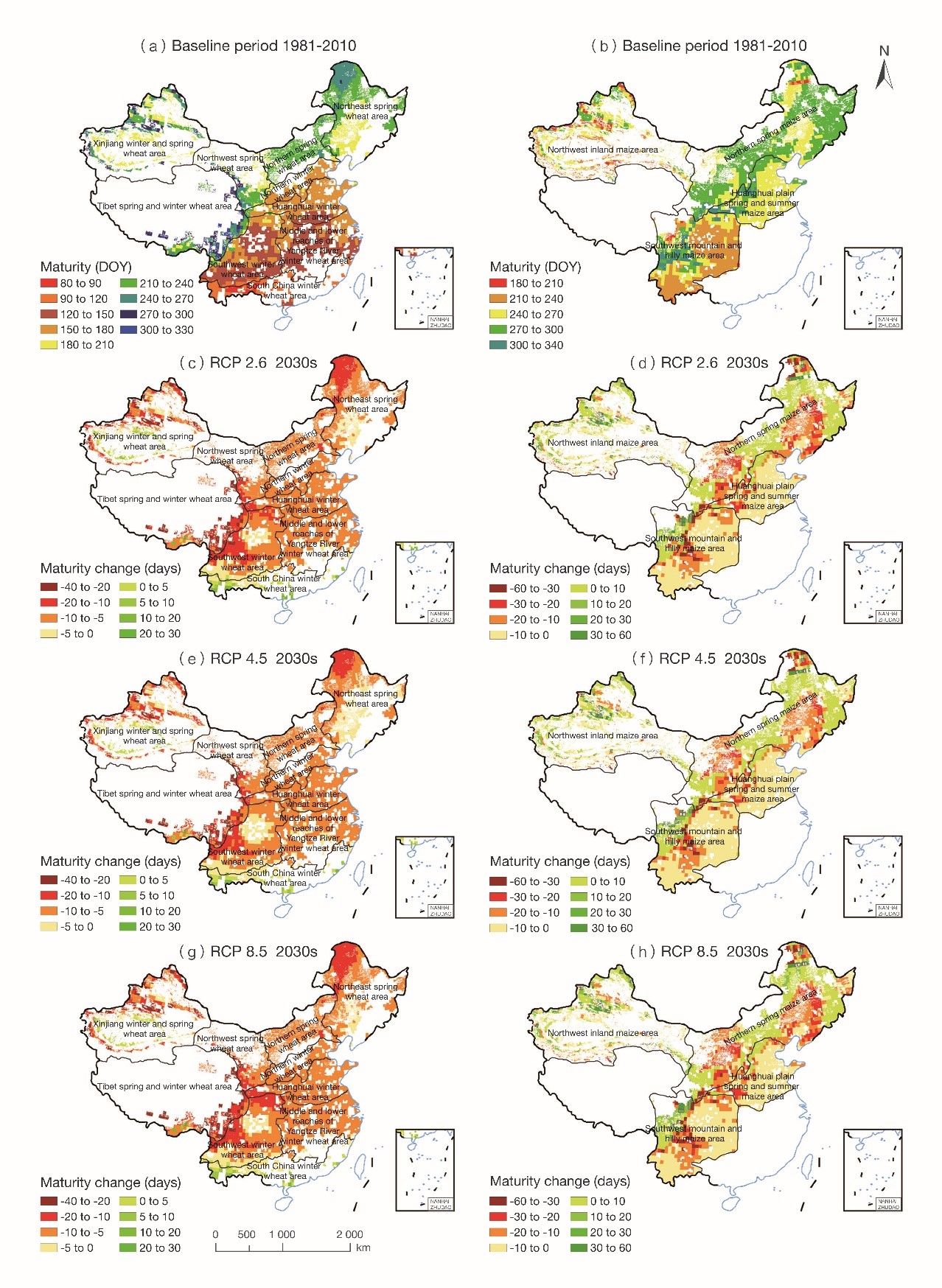SDG13: Climate Action
Predicting the impacts of climate change on the phenology of China's main crops(2020)
Target: 13.2 Integrate climate change measures into national policies, strategies and planning.
| Highlights |
| Projections of Changed phenology of China's main crops through the 2030s (2011-2040) put the probability of early maturation of wheat and maize at 90.4%-91.2% and 62.9%-64.5% respectively. Without appropriate interventions, climate change will lead to forward shifts in the phenology of these crops and shortened cycles of growth, with negative implications for wheat and maize yields. |
Background
The impact of climate change on food security is a matter of wide concern. Climate change not only leads to altered crop phenology, but also further affects crop yields and threatens socioeconomic stability through its impact on agricultural production and related industries (Liu et al., 2018a). This impact is likely to continue into the future. Therefore, forecasting changes in the phenology of main crops under future scenarios is instrumental in developing appropriate adaptation measures and ensuring regional food security (Liu et al., 2018b). This study presents near-term projections on the spatial distribution of the phenology of China's main crops with a validated crop model, refined by multi-model and multi-scenario probabilistic predictions to reduce the uncertainty in climate change assessments.
Data used
Data on climate change scenarios (RCP 2.6, RCP 4.5 and RCP 8.5) obtained from the Inter-Sectoral Impact Model Intercomparison Project.
Experimental data (crop growth and field management records) and meteorological data (daily minimum temperatures, daily maximum temperatures, total daily precipitation and sunshine hours) captured and provided by the agrometeorological observatories of the China Meteorological Administration for model validations.
Soil data obtained from the China Soil Database and experiments of agrometeorological observatories.
Method
For the purposes of this study, areas where the planting ratio was greater than 0 were selected as study areas and a crop growth model (Decision Support System for Agrotechnology Transfer, DSSAT-Wheat/Maize) was used to predict China's wheat and maize phenology under multiple scenarios (RCP 2.6, RCP 4.5 and RCP 8.5) through the 2030s (2011-2040). The simulation accuracy of the validated DSSAT-Wheat/Maize model is better than 90%. To assess future phenological changes of wheat and maize under the no-adaptation scenario, field management was kept at the same level as in the baseline period. This study aimed to obtain the average values of five atmospheric circulation models by scenario to generate climatic conditions under corresponding climate change scenarios (RCP 2.6, RCP 4.5 and RCP 8.5). Additionally, in order to make the prediction less uncertain, the kernel density estimation method (using Gaussian kernel function) was chosen to estimate the probability density and interval of phenological changes. Furthermore, since the influence of CO2 concentration was also considered, it was necessary to set the specific value of CO2 concentration by target period and scenario during the simulation process.
Results and analysis

Figure 5-3. Spatial distribution and changes of wheat (a, c, e, g) and maize (b, d, f, h) maturation in China under climate change scenarios
The spatial distribution of wheat and maize maturation, and changes thereto, in the 2030s are shown in Figure 5-3. Compared to the baseline period of 1981-2010, over 90% of the areas show forward shifts in wheat phenology through the 2030s under all scenarios. The greatest forward shifts in wheat phenology are predicted for those areas in Qinghai and Tibet where spring and winter wheat is grown, while the areas with delayed phenology are concentrated in winter and spring wheat areas of Xinjiang and winter wheat areas of South China. Compared to the baseline period, the flowering period (anthesis) of maize is brought forward under most scenarios, and early anthesis is predicted for 98.0% of the regions under the RCP 2.6 scenario, most notably in the southwest mountainous and hilly maize-growing regions. Unlike anthesis, there are substantial differences in the changes of maize maturation from region to region, with the greatest forward shift in the maturation of maize predicted under the RCP 8.5 scenario. As the latitude decreases, the wheat anthesis and maturation periods change from earlier than the baseline to later than the baseline, which is the most obvious under the RCP 8.5 scenario. In contrast to wheat, delayed anthesis and maturation of maize tend to be concentrated at high latitudes.
In the 2030s, the probabilities of early anthesis and early maturation of wheat are 88.9%-89.1% and 90.4%-91.2% respectively, and the probabilities of early anthesis and maturation of maize are 97.2%-98.0% and 62.9%-64.5% respectively. Under any of the scenarios, the probability of early anthesis of maize is greater than that of wheat, while the probability of early maturation of maize is less than that of wheat. Under the RCP 2.6, RCP 4.5 and RCP 8.5 scenarios, the probabilities of early anthesis for wheat and maize decrease progressively. In the case of RCP 2.6, the probability of early anthesis of maize is as high as 98.0%.
Outlook
Uncertainties abound in the projections of the impacts of climate change. Although uncertainties associated with model output and emission scenarios were factored into the ensemble-based predictions and crop modeling was validated by area to the greatest extent possible, to make the simulation more accurate, a degree of uncertainty remains in the simulation of biophysical processes of the crops.
Future climate change is likely to aggravate the fluctuations in China's wheat and maize production, hence the need to take adaptation measures as a matter of urgency to ensure food security. Improving crop management is an effective way to boosting the resilience and adaptive capacity of agriculture against climate change. Measures such as adjustments to sowing dates, fertilization and irrigation can mitigate the adverse impacts of climate change. Transforming the patterns of photosynthesis of crops through the use of improved crop varieties or breeding new varieties that are more heat tolerant and require more heat is also an important strategy to improve the resilience and adaptive capacity of agriculture.

